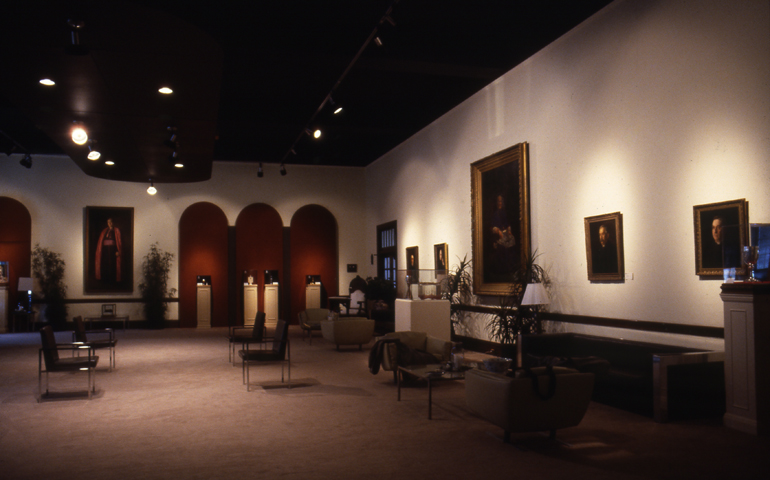
The Eakins room at St. Charles Borromeo Seminary in Philadelphia (William Innes Homer)
St. Charles Borromeo Seminary in Philadelphia has announced that it will sell seven of its important paintings as part of a campus-wide consolidation plan. Six of the works are by 19th-century painter Thomas Eakins, whose work titled "The Gross Clinic" sold for $68 million in 2008.
Christie's has been hired to sell five Eakins works: "The Right Reverend James F. Loughlin" (1902), "Reverend James P. Turner" (1900), "James A. Flaherty" (1903), "Dr. Patrick Garvey" (1902) and "Archbishop James Frederick Wood" (1877). The seminary has also enlisted Bonhams to sell Colin Campbell Cooper's "St. Peter's Cathedral" (undated) and Sotheby's to sell Alice Neel's "Archbishop Jadot" (1976).
A sixth Eakins painting, owned by the American Catholic Historical Society and on display at the seminary, is also to be sold.
"The seminary has long been a steward of these works, but this was the right time to seize an opportunity to do what is best for the artwork and for the seminary itself," Auxiliary Bishop Timothy Senior, seminary rector, said in a March 21 statement. The seminary's core mission is to form men for priestly service, he added. "We are not a museum."
Although the church has had a role as arts patron and collector throughout the ages, Ori Soltes, a professorial lecturer in fine arts and theology at Georgetown University, agrees with Senior's distinction. At a seminary, artworks tend not to get the same degree of protection or visitor foot traffic that they could at a museum, he said.
"I think, by comparison, of the uproar when the Rose Art Museum at Brandeis University decided to similarly liquidate its collection of works by American Jewish painters," Soltes said. "In that case, a public institution whose raison d'être was to own, care for and display that array of works was forced by its finances to give them all up. This does not apply to the seminary."
Tom Freudenheim, former assistant secretary for museums at the Smithsonian Institution in Washington, D.C., and former director of the Baltimore Museum of Art, agrees.
"It seems to me that if these have serious market value, then retaining them isn't really the best way for the diocese to maximize use of its assets," Freudenheim said. "Moreover, taking care of valuable works of art isn't something for which they should be expected to have expertise."
The value of the works may be difficult to judge. Just being Eakins works, they have some value, Soltes said, but given their subjects -- former St. Charles Borromeo seminarians -- they are more valuable to the seminary than to the public. It remains to be seen how deeply collectors are willing to delve into their pockets.
"They are more valued than valuable, which makes for a potential irony if, in spite of the voraciousness of the current art market, they don't draw the prices that are no doubt hoped for," Soltes said.
"We wouldn't comment on estimated value at this time," said Ken Gavin, the archdiocese's director of communications. "It would be imprudent to influence the coming sale in that fashion."
A search on the Sotheby's and Christie's websites for all listed sales of Eakins paintings since 2010 reveals that Sotheby's sold six works in that time frame for a combined $623,500, while Christie's sold eight since 2010 for a combined $343,625.
Two works in particular trounced their pre-auction estimates. Christie's sold "Mrs. Samuel Hall Williams" for $134,500 -- more than 11 times the high end of the estimate -- while the selling price for Sotheby's "Portrait of the Artist's Sister, Margaret Eakins," was also $134,500, two-and-a-half times the top of the estimate.
"The market is extremely strong for Eakins," said Eike Schmidt, the James Ford Bell Curator of Decorative Arts and Sculpture at the Minneapolis Institute of Arts and a former head of the European Sculpture and Works of Art department at Sotheby's in London.
Eakins' "The Gross Clinic" was the record seller at $68 million, "although the tag would have been even higher if there wouldn't have been a controversy about the fact that it is historically connected to Philadelphia and should stay in town," Schmidt said. "The works which were sold in the past four years were all minor compared to such an iconic work as 'The Gross Clinic,' and still they did very well financially."
Soltes questions the extent to which the public "is interested in portraits of former seminarians because the portraits were painted by Eakins." But, he said, those who do want to see the works might have more of an opportunity to do so, depending on whether a private collector or a public collection purchases them.
"But how many of them knew they were at the seminary and visited or could visit to see them in the past decades?" he said. "I'd like to see the demographic information on that."
About 300 people have attended an annual sacred art tour and open house at the seminary each year, and about 50 people each year have seen the Eakins portraits on other requested tours, according to Gavin. "Many Eakins scholars have also spent time studying the collection," he said.
A news release quotes the rector as saying the seminary's hope is that the Eakins works "will find a home where they can be well cared for and viewed widely by people from across the country." However, Gavin clarified that the works might go to a private collector.
"It is a hope but not a line in the sand," he said. "Christie's has also indicated that they believe that the most likely purchasers would be museums that would like to have an Eakins in their collection."
After the sale, the seminary will be left with about 200 paintings, some of which were in the Cathedral Basilica of Sts. Peter and Paul in Philadelphia before it was renovated in the 1950s, according to Gavin.
"We do not consider the [Eakins] paintings which are being sold to be 'sacred objects,' " Gavin said. "They are significant to the history of the seminary, but they are not relics. Neither the seminary nor the archdiocese would sell sacred objects such as chalices, patens, ciboria, tabernacles, [or] altars to museums or private collectors."
Nora Heimann, chair of the art department at The Catholic University of America in Washington, said it is "very sad that a fellow institution now feels itself compelled to sell off the historic works of art by this vanguard master."
St. Charles Borromeo Seminary's collection is one of several significant art troves at U.S. Catholic institutions, according to Heimann. Others include Fordham University's Museum of Greek, Etruscan and Roman Art; Marquette University's Haggerty Museum of Art; and the University of Notre Dame's Snite Museum of Art.
"Thomas Eakins is one of America's greatest artists, and he was among the most important portrait painters and pioneering photographers of the long 19th century," she said.
However, the sale is an "expedient way to raise cash," she said, and much less problematic than either Brandeis' efforts to sell its collection or Randolph College's recent sale of George Bellows' "Men of the Docks" from its Maier Museum of Art. That sale occurred "despite the condemnation of many in the college community and the art world," she said.
"That said, I find this [Eakins] planned sale disappointing in its lack of vision -- if not wholly surprising given an increasingly pervasive trend in higher education towards 'corporatization,' in which all assets are expendable, from human capital to cultural patrimony," Heimann added.
[Menachem Wecker is a freelance reporter in Chicago.]




